Refinements
10/10/2021. A photograph and a few notes from this morning.
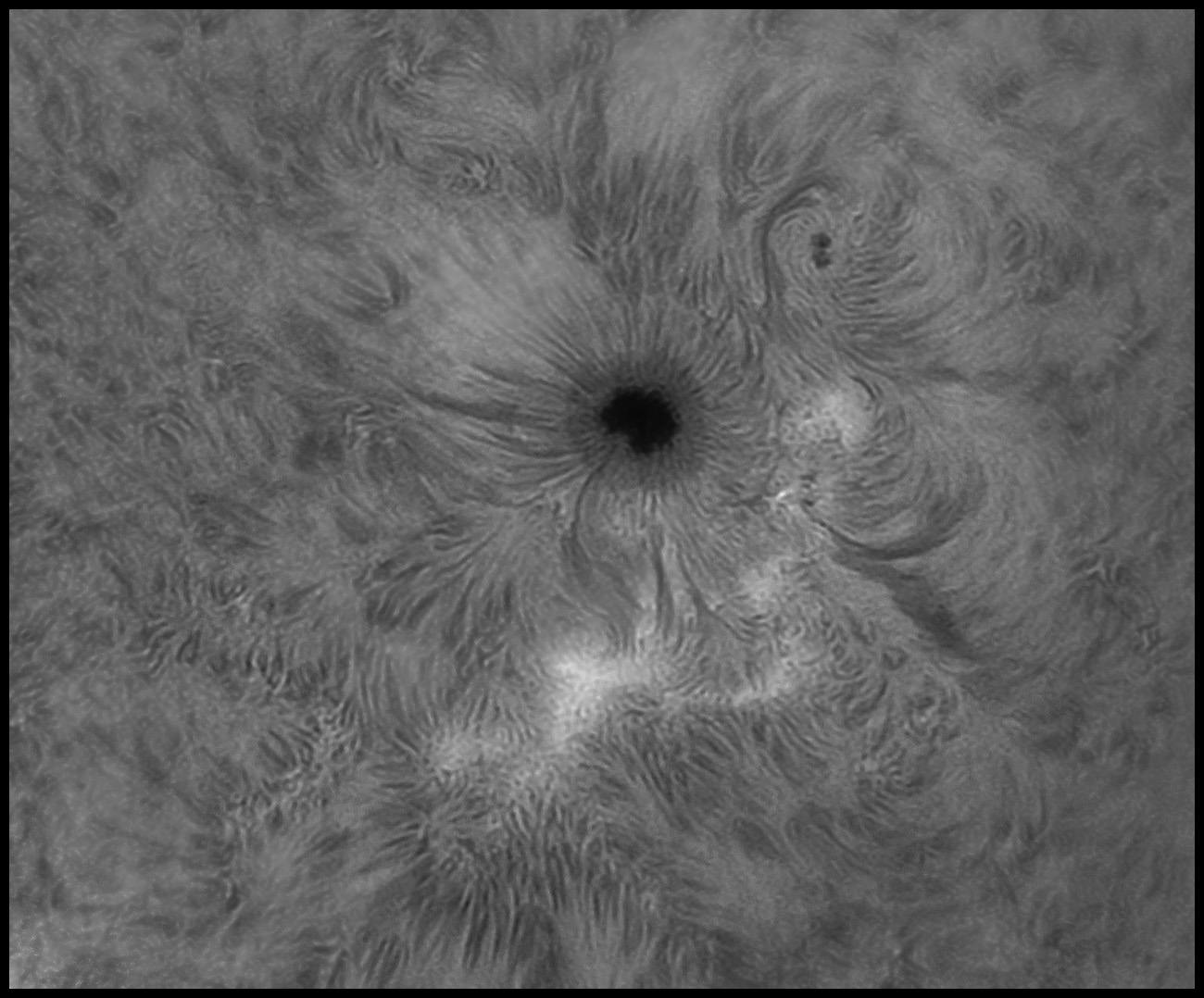
Best 400 of 3,000 frames, exposure 0.7ms.
Gamma off, flatfielded in Firecapture.
AS!3, IMPPG, PS for polish.
- The order of operations matters in IMPPG. (D'uh. Of course it does.) Unsharp Mask before L-R Deconvolution. A little more USM is fine later.
- 10,000 frames is not too many. 400 / 10,000 is slightly sharper than 1,000 / 10,000, but the latter is significantly smoother. Choose your poison. Tossing the videos feels like tossing negatives -- just wrong -- but I really can't be archiving 30+ GB of data every time I photograph some solar doohickey. I'll probably start just saving a generous set of AS!3 tiffs except in unusual cases.
- It probably is better to capture in Firecapture with gamma off. The finished result of a 400 / 3,000 stack from a clip without a gamma push (and with exposures half as long) is sharper, better than from a similar clip with gamma maxed out. It actually rivals the deeper stacks I was just on about. The video isn't as pretty, but that's not the point; the finished image is. See the picture above. You can focus and compose with gamma as you wish and then disable gamma with a single (un)check mark to capture. No big deal. Just don't panic in post. The information is in there.
- One weird combination worked well today: I took a very tall stack (10,000 frames) early on and another about half an hour later. On a whim, I layered the best thousand from the first atop the best thousand from the other and tried various blending modes. I was looking for differences but tried a few things while I had the data in front of me. Multiplying the layers while reducing the top layer's opacity to about 35% produced beautiful tones. Maybe that worked by emphasizing flowlines on the Sun, maybe by some purely graphical effect. Anyway, keep that in mind, but also remember that two 10,000-frame clips require a total of about 60GB of storage. So don't make it a habit if you mean to keep the source files.
- Try the .SER format again now that you have the tools to use the increased bit depth.
- By literally peeping at pixels in the refined full-rez image, I can see that the finest details are approximately 4 pixels across. That suggests we are seeing things down to about 1.8 arc seconds. The Airy disk of a 90mm lens operating at the H-a wavelength is ~1.82 arc seconds: arcsin(1.22*w/d). We're there.
10/11/2021. When the sky cleared late, I had time to find the Sun, focus, take a flat and almost start a capture before clouds returned to block the view. I began to pack up. The sky suddenly cleared. You're not fooling me, says I, but when the light stayed strong, I says, I says, shit!, you're here, set it back up, and take some data. Which I did. This is the best 400 of 5,000 frames using some of the tips ennumerated above. Zero gamma; crap video but a good stack after post.
At 4:30, the Sun was just 25 degrees high. The whole "lucky imaging" schtick is about defeating seeing to approach diffraction limits, so let's see how it works under "challenging" conditions:
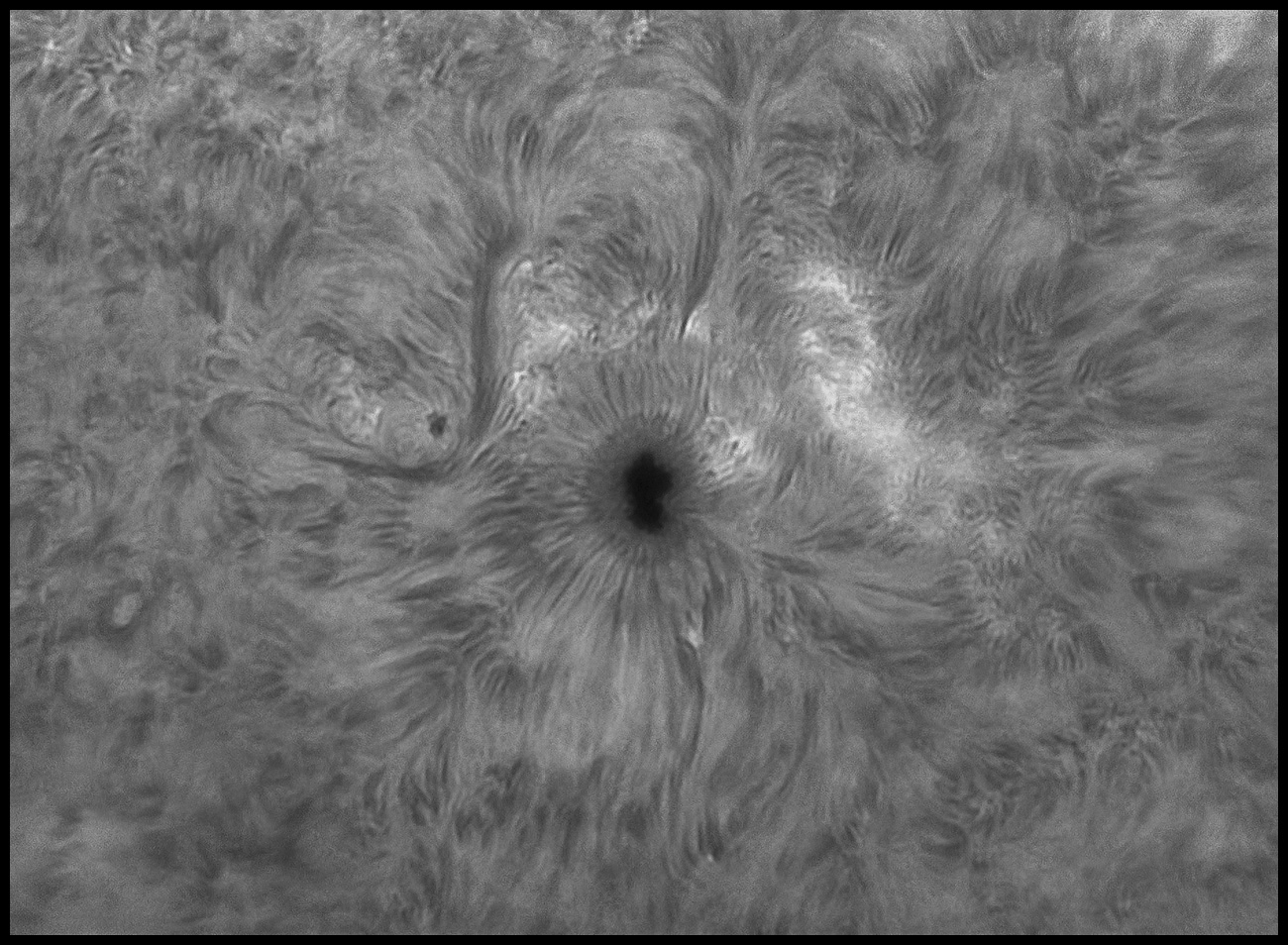
Best 400 of 5,000 frames, exposure 2.1ms.
Gamma off, flatfielded in Firecapture.
AS!3, IMPPG, PS for polish.
Pretty well, I'd say. Captured at 2000x1600, aligned and stacked ~1800x1400, resampled to 1280 for the web. For the record, it takes half an hour to drive to the community lot, set up the telescope and computer, take data, tear down, and drive home (a little longer if the weather is "playful" and you have to do some of that twice).
10/12/2021. Out and at it early, before the air warmed up but with the Sun decently up. I made a point of taking both AVI and SER files this morning and was surprised to see that the latter were just as fast and the same size as the former. Duh: I thought SER was always deeper, 12- 14- or 16-bit data, but no, I was taking 8-bit data and storing in the SER format. So, no advantage there. Will revisit that question later. The only time I would really like to have extra bit depth is with surface detail and prominence features in the same frame. And as you can see from this AVI-derived triptych, it's not entirely necessary for that, either:
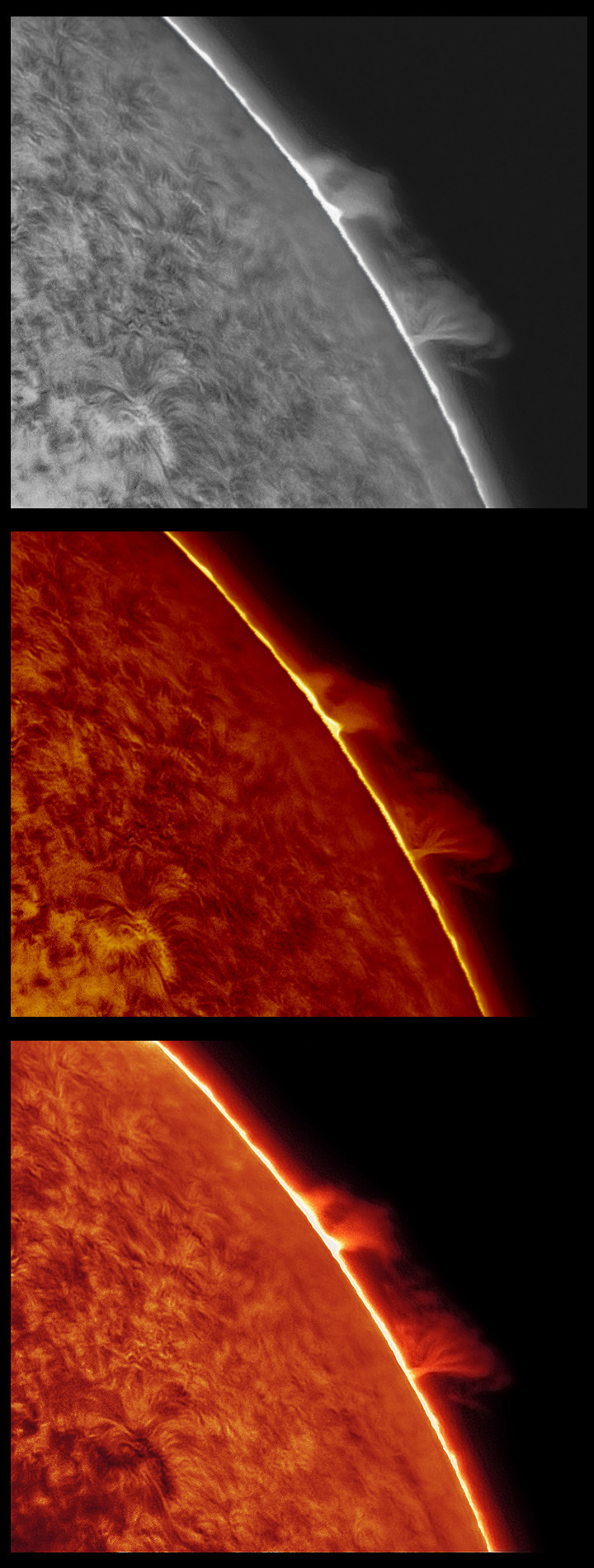
As for surface imaging, I thought I had good data this morning. I had calm air, a clear sky, and I took my time. The power distribution panel failed, but that's no big deal; I only need one plug for the solar kit, so I just unplugged the panel and plugged into the battery directly. [Blown fuse in the plug. I think when unplugging the panel without pulling directly outward, strain on the wire pulled the pos and neg contacts together and produced a perfect short; I bent the tabs farther apart and wrapped the pos side in black tape; I've put the equivalent of a penny in there rather than a fuse, so I'll need to replace that by and by.] But something about today's imaging was just that little bit off. Out of 100GB of data exactly one clip and one run through AS!3, IMPPG and PS actually produced a decent image (two if you count that mess just above). Practice, mister, practice. Was the histogram a little too far left? Maybe a little more gain would help, or a lot more gain and shorter exposures? Did I bump the focus or maybe screw up today's flat? Or maybe big ole AR 2882 is just no longer as perfectly presented on the face of the Sun.
10/13/2021. That's more like it. Whatever wasn't quite working yesterday morning got over it by this afternoon. I was careful to capture a proper flat and to expose just a little more generously. I took a 3,000 frame snapshot between the clouds and a 10,000 frame stack after the sky cleared. The latter produced excellent details. A quick look around the rim found this fire-breathing dragon. AR2882 is the best thousand of ten thousand frames. The exposure was 2ms; that newly-active c-flare-producing region just ahead of the big spot kept me from going even longer, the better to move the histogram to the right, up and away from noise. The prominence photo is the best four hundred of three thousand frames (8.3ms each).
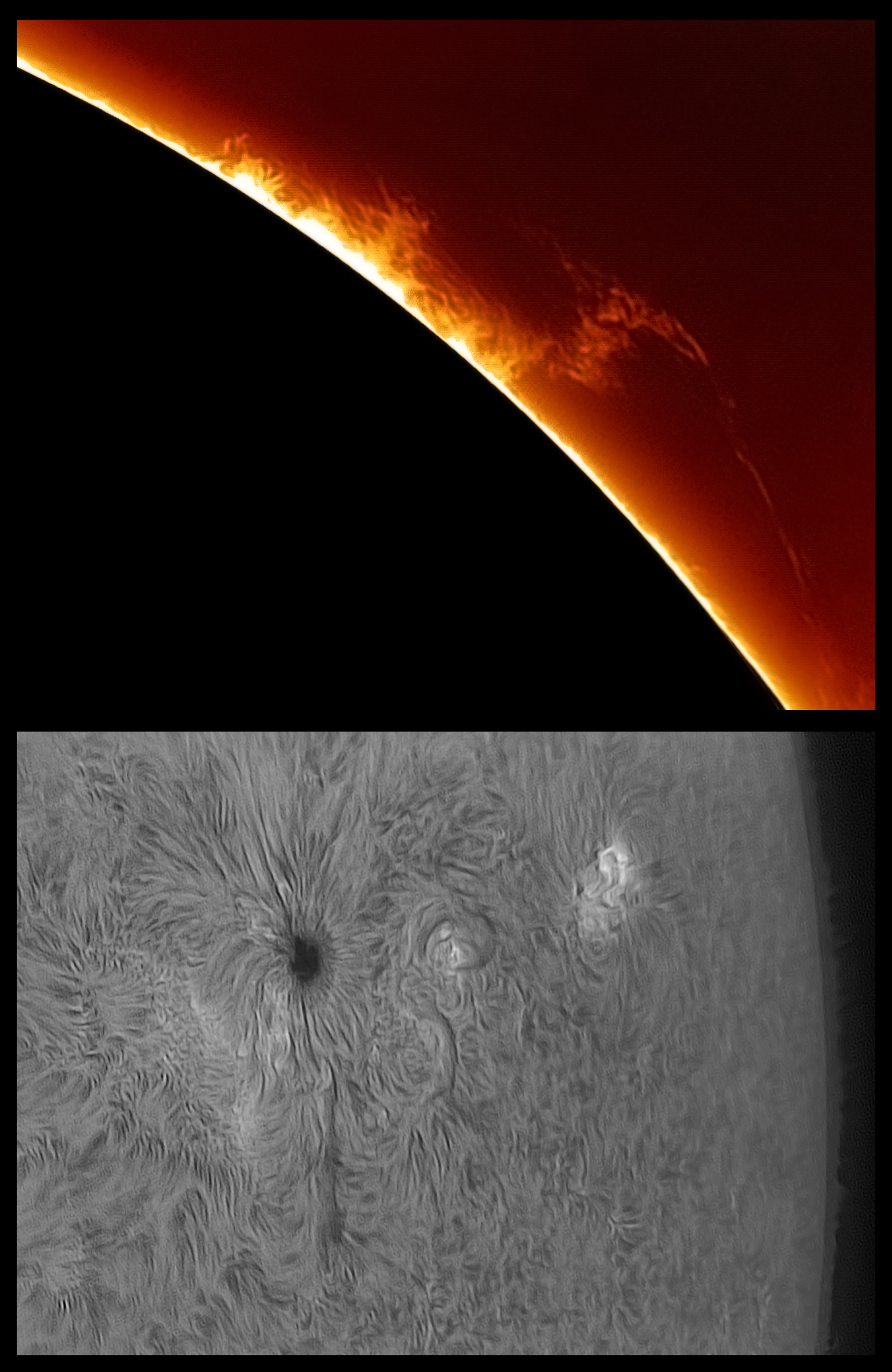
Yeah, you could make that big.
The first clip of the day, just a quick 3,000 frame snapshot (I love having a fast camera) between the clouds caught a very quick, very intense, barely C-class flare in an isolated active area beyond the main attraction (best 400 frames of 3,000):
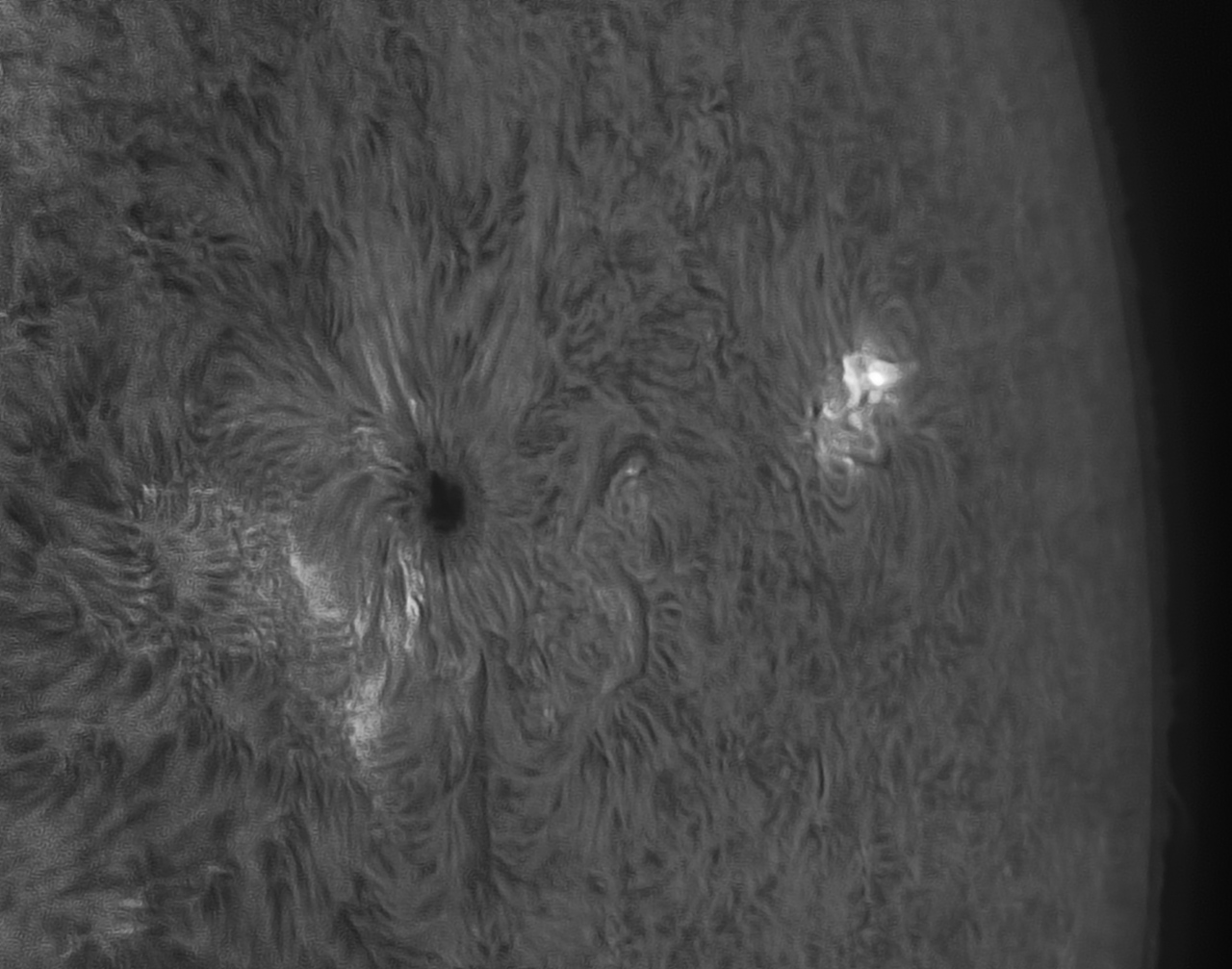
In other news, I canceled an order for a lithium battery in favor of a lithium-based jump-starter / power-bank with similar capacity. For my needs, the 12v output should be just as robust as anything I can cobble up, plus it's smaller, has built-in charging circuitry, a power monitor, and USB outlets. And it can start my car. Also, I can re-deploy the telescope battery for the UPS on my computer. So, hey, it all works out. News soon.
I rebuilt the Baader AstroSolar filter for the 10-inch R-C today (cat jumped through the last one). A "vintage" Tupperware pie keeper is enroute from eBay to serve as its carrying case and cat-resistant storage container. I need to do a proper filter for the TMB92SS next; the one I put together for the 2017 eclipse is not all it might be. I aim to practice with the Sun and be ready for some lunar imaging again soon (something I last attempted in 2012 with gratifying success) and maybe some planetary stuff, too. It's easier to debug these outfits by daylight than in the dark. Who knows? If I can make it (almost) as easy to set up the 10-inch as it is to deal with the solar kit, I might get back to doing some deep-sky locally and be readier to take advantage of my next trip to the dark, too.
10/14/2021. 8- or 16-bit? I finally took some back to back data to compare an 8-bit AVI to a 16-bit SER. Here, can you tell which is which?
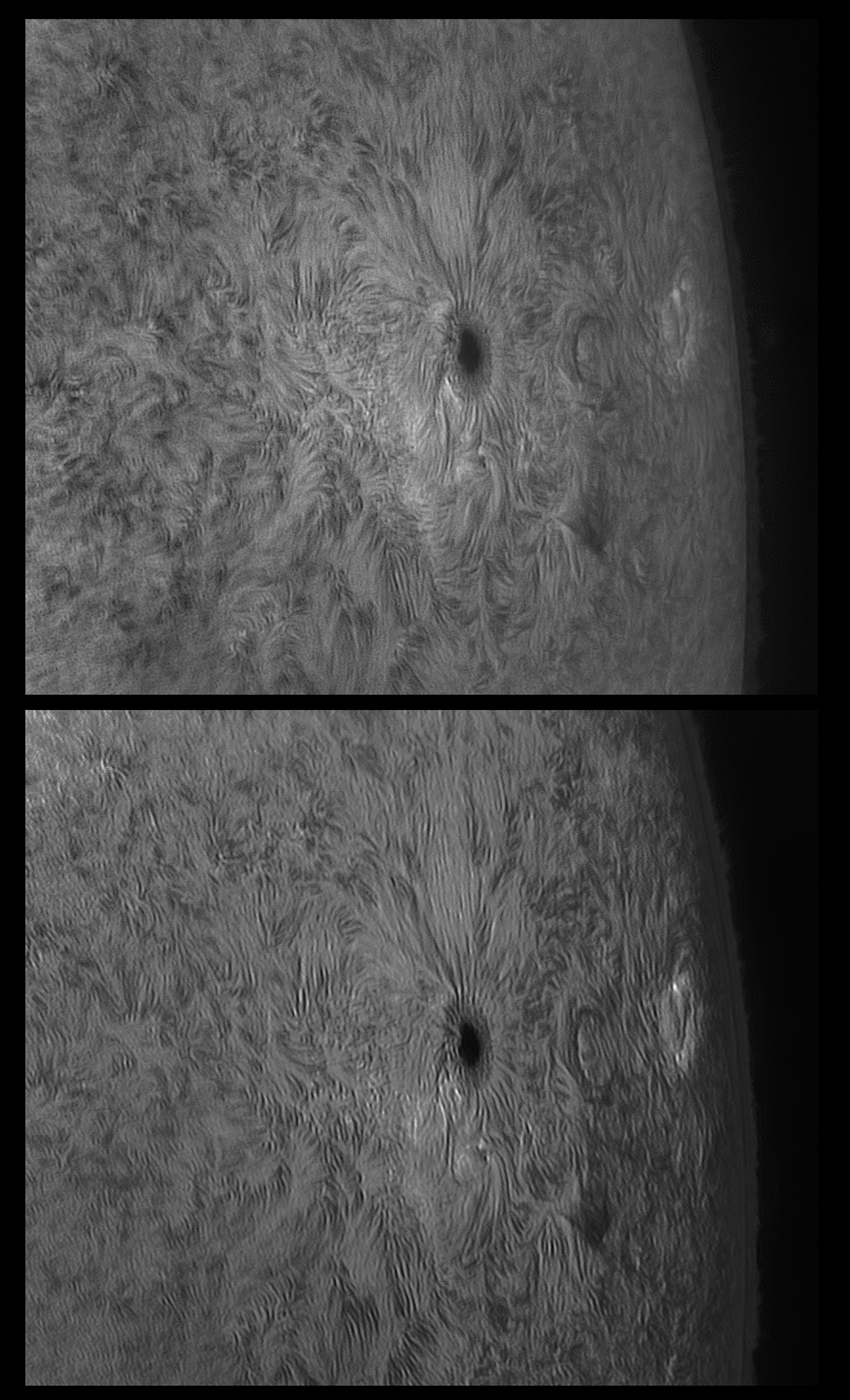
No, really: can you tell? Because I'm no longer sure which is which. When I first stacked these data, I thought the 16-bit set showed the chromosphere in profile better and surface detail seemed finer and less noisy (as might be the case if the ADU discards the lowest order bits). And there are (arithmetically) many, many more levels of grey to work with. But after running both through the usual post-processing wringer, and taking care not to know which one I was working on, I'm no longer sure which is on the top and which is on the bottom. Keep experimenting with this.